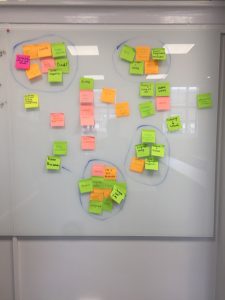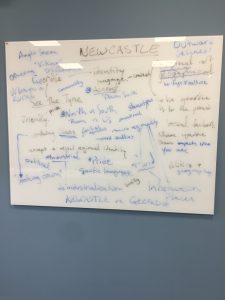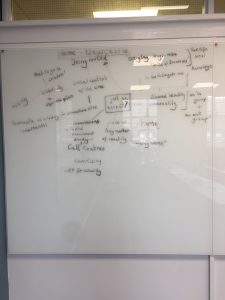You’ll need to zoom in on the photos to read our whiteboard ideas, but here’s a record of our classroom discussions yesterday.

These are some of the many really interesting points that came out of our discussions yesterday:
Regional identity
This idea that regional identity was loosing relevance, and in particular whether the ‘next generation’ (youth in the UK) are thinking more ‘nationally’ rather than regionally compared to previous generations (in the wake of Brexit? we mused). If you’re interested in this, have a look at Paasi’s work on regional identity:
Paasi, A, Region and place: regional identity in question, Progress in Human, 2016, Vol 27, Issue 4, pp. 475 – 485

Fluidity
Another point made was about the fluidity of identities, and this contestation between an ascribed identities and attributed identities. Take a look at Brah’s seminal work on Diaspora which argues that identity is fairly fixed culturally but malleable geographically:
Brah, E. 1996: Cartographies of diaspora: contesting identities. London: Routledge
Personal versus place
There was also some argument around whether our personality and familial ties and relationships governed our sense of place, rather than or physical geography. There was mention of ‘being born on the banks of the Tyne’ as a physical definition of being a Geordie, but then talk of accent as imperative to belonging and claiming identities. Something that we didn’t touch on, were experiences and memories of place, and in particular our sensory reception and then projection of place through these experiences. If you’re interested in this more psycho-geographic approach to identity, take a look at the work of Hough:
Hough, M, Out of Place: Restoring Identity to the Regional Landscape, Yale university Press, 1990: New Haven and London

Places that have a placed identity / ‘authentic places’
Another area of discussion was around some places having more of a placed identity than others, so Newcastle, for example, having many cultural and literary associations and stereotypes, having many physical outputs and industries, and being widely portrayed and ‘known’ in popular culture. All these aspects help to authenticate and brand the city, and with it, an identity that goes alongside the city. If you’re interested in this, there’s a very interesting article by Sim, who looks at the branding and authenticating of two towns in the Lake District via their food heritage and outputs.

(Souvenirs: branding and creating the city: photo taken during our live photostream exercise)
Sims, R, Food, place and authenticity: local food and the sustainable tourism experience, Journal of Sustainable Tourism, 17:3, 2009
There’s also some interesting work coming from urban planning and architecture on place making and place shaping, that looks at how to design spaces with placed identity in mind. Take a look at:

